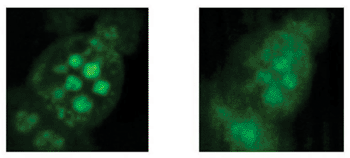3i To Develop Temporal Focusing Microscopes
By LabMedica International staff writers
Posted on 31 Jul 2012
The imaging potential of new Weizmann instruments microscopes will soon be expanded. Yeda Research and Development (Rehovot, Israel), the technology transfer arm of the Weizmann Institute of Science (Rehovot, Israel), has signed a license agreement with Intelligent Imaging Innovations (3i; Denver, CO, USA). The advanced Weizmann microscopes will be developed into commercial products by 3i. Other microscopy systems based on Weizmann research are being sold by “Idea Bio-Medical.”Posted on 31 Jul 2012
Confocal microscopy commonly used to obtain three-dimensional high-resolution images of living cells and tissues, works by focusing a light beam on the sample, illuminating it one point at a time. However, this point-by-point scanning can take too long. For example, in some brain studies, scientists need to illuminate an entire network of neurons in a particular brain area simultaneously. Such illumination will now be possible using the new Weizmann Institute temporal focusing microscopy, invented by Prof. Yaron Silberberg and Dr. Dan Oron of the physics of complex systems department at the Weizmann Institute.

Image: Microscope images of cells (r) with and (l) without temporal focusing (Photo courtesy of the Weizmann Institute of Science).
The temporal focusing microscopy works by controlling the focus of a laser light beam in time rather than in space: light is beamed at the sample in long pulses, which shorten when the beam reaches the desired plane, producing the needed illumination. In this manner, a single exposure to a light source can illuminate an entire brain area.
The method allows for outstanding precision: pulses lasting several femtoseconds target specific neural network components in a millimeter-thick sample of brain tissue.
Dr. Karl Kilborn, copresident of 3i said, "We look forward to incorporating temporal focusing in several upcoming products designed for optogenetics, as well as for other photomanipulation applications. In all such applications, a simultaneous illumination of numerous cells, or numerous parts of one cell in a single plane, is critical. It is essential for understanding the behavior of complex neural circuits or other biological phenomena that occur too fast for studying them with sequential illumination approaches."
Other optical systems based on Weizmann Institute inventions such as WiSoft, Argus, and Hermes are marketed by Idea Bio-Medical Ltd., a daughter company of IDEA Machine Development, Design and Production Ltd. (Rehovot, Israel). These systems enable scientists to perform imaging of living cells and cellular structures at high resolution and in high throughput, without losing important biological information. The images are produced with the help of dedicated software that enables a rapid analysis of the data.
Related Links:
Yeda Research and Development
Weizmann Institute of Science
Intelligent Imaging Innovations (3i)














